The final phase of our vacation in Morocco had begun. With Nicole and Connie safely on their way back to the USA, our travel group was back down to the family group, same as it had begun a week and a half ago. Our next destination was the incredibly famous, highly photographed “blue city” of Chefchaouen. Mom mentioned that she was pretty sure it was on the cover of all of the ‘visit Morocco’ guidebooks she owned, and pictures of the city may have even played a part in creating her initial wish to visit the country over a decade ago. So, good work Chefchaouen; you’re a beacon to tourism for the nation.
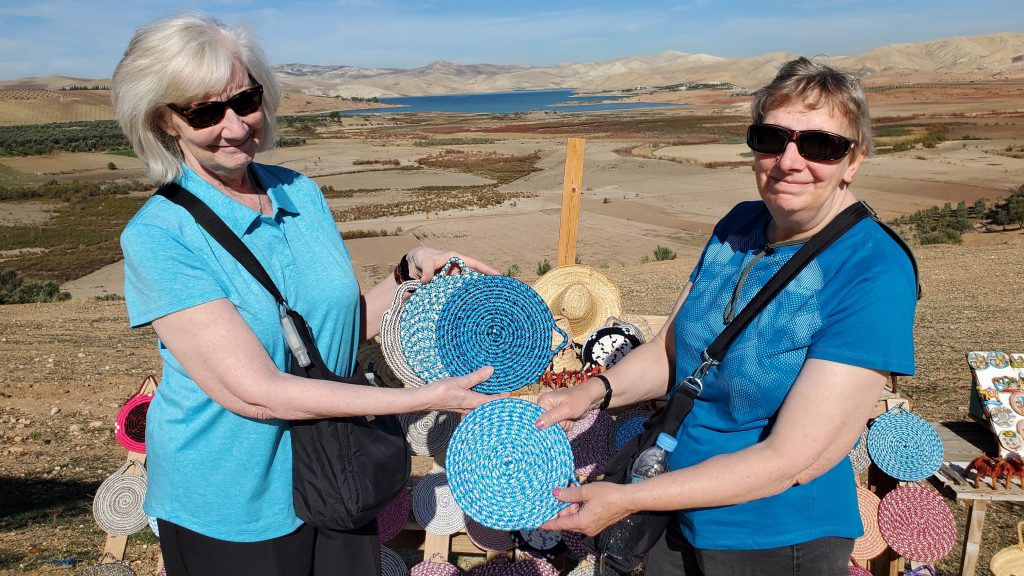
Part of the journey involved stopping by the ancient Roman city of Volubilis for a couple hours, one of the best-preserved examples of Roman influence on the south side of the Mediterranean. Omar said that Odynovo Tours had subcontracted this part of the trip to a local guide, Amarad, who lived in the nearby village of Fertassa. Amarad’s command of English wasn’t great, but he was enthusiastic in his descriptions of the various surviving Mosaics that had been unearthed over the past couple centuries before the site reached UNESCO status. Almost no trees were allowed to sprout up in the extremely low ruins so the November sun beat heavily upon us. Apparently a lot of the Roman stones had been repurposed by various rulers over the centuries to build the city of Meknes a couple dozen kilometers to the south, explaining why the surviving city ruins were “knee high.”
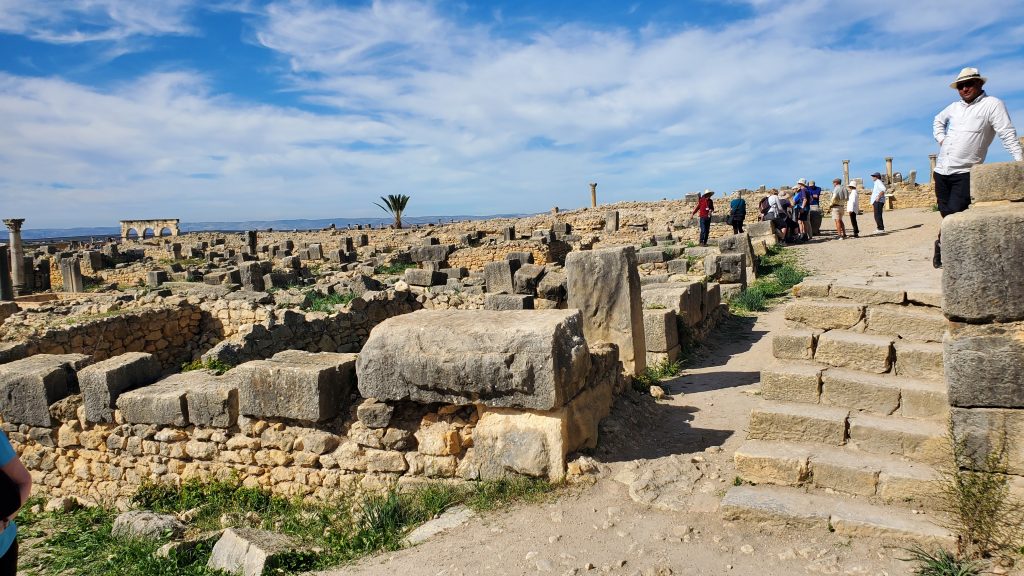
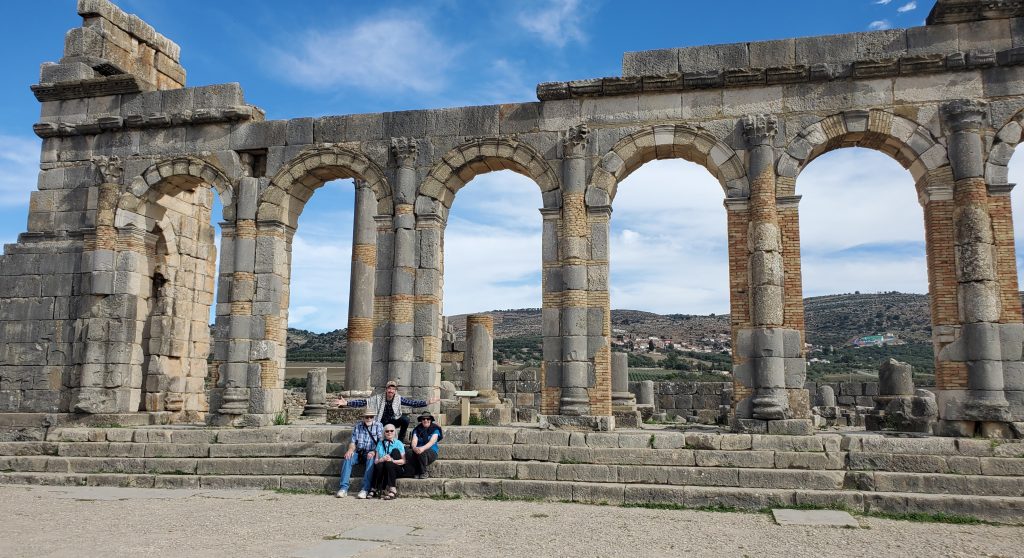
We reached Chefchaouen in the early evening as the sun was starting to set. Nestled into the hills between two mountain slopes, we examined it from one of said slopes alongside a small tour bus of about 20 Asian tourists. From up here, it didn’t actually look that blue and I wondered where the heck the pictures came from; I was expecting to crest the hillside and look down onto a town that might as well be as blue as the sea. Omar explained that it was further in (here he gestured to a section of town in the northeast corner of the city) that they painted everything blue, and it was difficult to see from here.
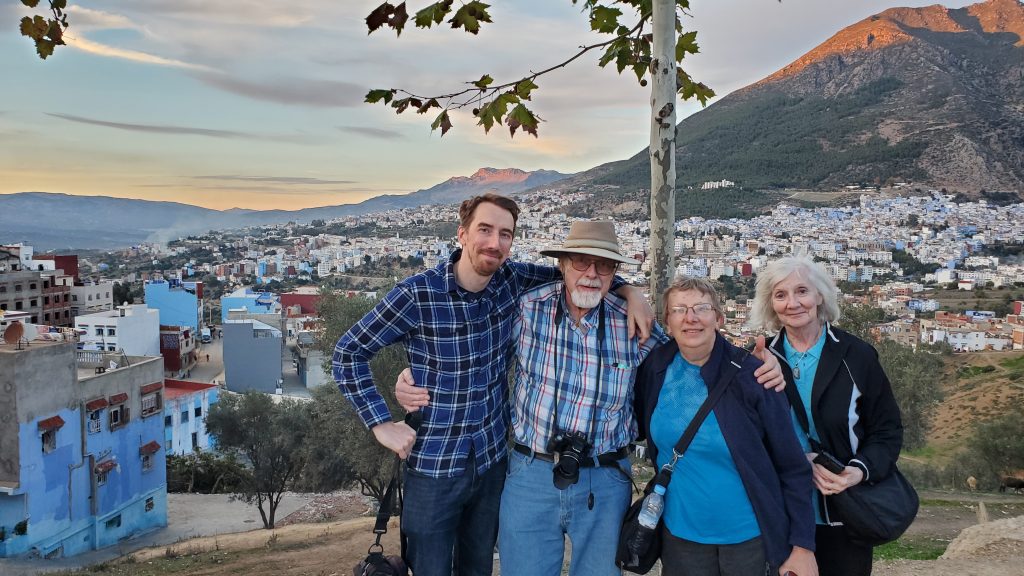
It turned out that our big Mercedes touring minibus (large van?) was not allowed to go into the old city where our hotel was, so Omar flagged down a couple of taxis to take us and our luggage up the narrow streets to “Vanci Hotel” where we’d be spending our single night in the city. In comparison to the Palais Faraj or Ksar Ighnda, it was a bit of a step down, but Odynovo had warned us that here in the high-tourism season of November, hotels in Chefchaouen booked up incredibly fast and this rather middling hotel was really the only place left that could accommodate the four of us in 3 separate rooms. As we were checking in, a group of 30 Asian tourists flooded into the lobby, led by a Moroccan guide. I can’t find any news articles about this but it was quite interesting actually; of course we had seen other tour groups on our trip so far, but here in Chefchaouen the vast majority of large groups were Asian. I mentioned this to Omar, and he said that he thought it was because traveling outside China had been somewhat difficult before 1978, ever since that point, Chinese tourism had been constantly rising, filled with tourists that were obsessed with taking as many pictures and seeing as much as they possibly could. When put in that perspective, I can completely sympathize that they finally were free to travel and therefore, wanted to make the most of it. Maybe there was also a worry that perhaps the Chinese Communist Party will take their freedom away again at their whim someday too?
Omar met us the next morning at the hotel at 8am to begin our walking tour. Several friendly local dogs who found us in the first 10 minutes of the walk seemed to enjoy our companionship, playing with a discarded shoe they had found (way to be stereotypes, dogs!) and romping within 20 feet of us for the first half an hour. It was still quiet at this time of morning except for gradually increasing sound of water. We came to the source eventually – a fast moving narrow channel of water that seemed to be used for washing by numerous stern looking elderly ladies. Omar cautioned us not to photograph them (I hope the Asian tourists got a similar memo), and we crossed a bridge over the stream and into the picturesque part of town. Here’s where the souvenir stands began and all* the walls were painted blue.
Why the asterisk you ask? Well, it seemed like in most cases, despite most of the buildings being 2, 3 or even 4 stories tall, in these narrow car-less alleys we were walking through, the blue color only extended up to the top of the ground floor – the upper areas were left the drab color of unpainted concrete. It definitely helped to explain why the previous day, when viewed from a distance, the city didn’t actually look that blue.
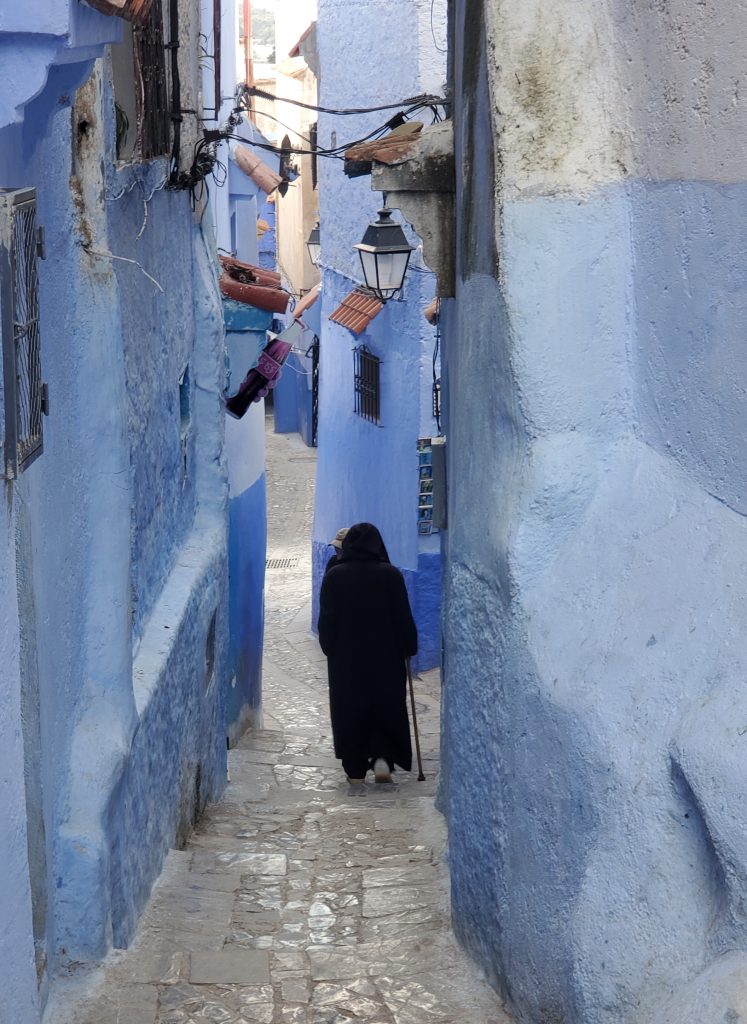
It was pretty, of course, but felt extremely touristy. In one town square, we came across a group of tourist women in lawn chairs who were simply painting a blue wall and alley. I was getting a rather bizarre vibe from the city by this point – what am I missing??? It’s a city with a lot of blue paint! Is this the best idea to make into tourism or what? I mean, I get that it has a historical background, having been inhabited by a lot of Jewish folks who were forced to flee Europe during the Re-conquest and the expulsion of all non-Christians from Andalusia.
We met up with Yassin outside the old city where vehicles were again merrily honking to each other and began driving to the southwest, heading toward Rabat, the latest and, hopefully(!) last capitol city of Morocco. It’s certainly seen quite a few over its centuries. Along the way we stopped at Motel Rif’s restaurant, which I just want to give props for having an amazingly attentive staff and Yassine Boukouri, the current owner and son of the founder, handed me a huge sack of pomegranates as we were leaving, for no reason! How are we going to eat all these before we fly out in a few days? What a nice guy though. The oranges we had for dessert were fresh, from his own garden, and were some of the best we’d ever eaten.
Our lodgings in Rabat were the polar opposite from Vanci hotel. We still needed to have a porter schlep our bags from a car-allowed street into an old city to reach Dar el Kabira, or “The Big House” where we’d be spending the night, but this place was a fantastic, 800-year old former home that had only been converted to a hotel in the past couple decades. A small courtyard (now enclosed, like Palais Faraj in Fes) with a water pump on its wall – I tried to imagine how awesome it must have been for the owners when they got water, and later electricity installed in this ancient building, and some ornate paintings on the wood made it very stylish and, in my opinion comfortable. Check out their photo gallery lower down on their web page for some idea of how swanky it looked.
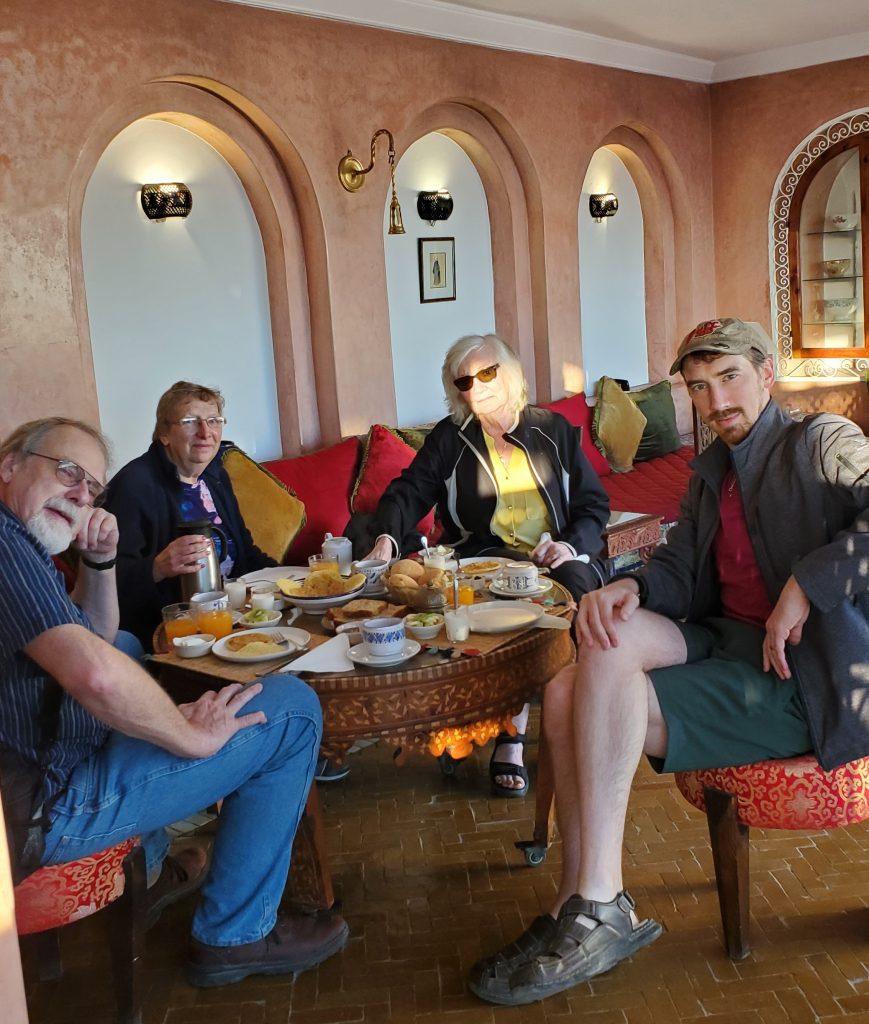
We went out on a hunt for some clearly labeled spices that evening, as my mom wanted to bring more “Ras al Hanoot” (which you might recall means “Head of the Store” and is the typical tagine spice) back to the USA – but R.A.H. is normally custom-ground and unique for each spice seller, and mom wasn’t too keen on bringing baggies filled with unlabeled reddish powder through customs in the airport. So the search was a bust.
Highlights of our Omar-guided walk the next day was through the old Kasbah, pretty close by the old city we were in now. It had some great overlooks of the Atlantic ocean. I noticed that there were several large cemeteries, densely-packed, consuming “prime real estate” right by the sea front. Here in the capital city where I assumed real estate, essentially oceanfront, would be at a premium, I was just surprised that the cemeteries hadn’t been relocated elsewhere.
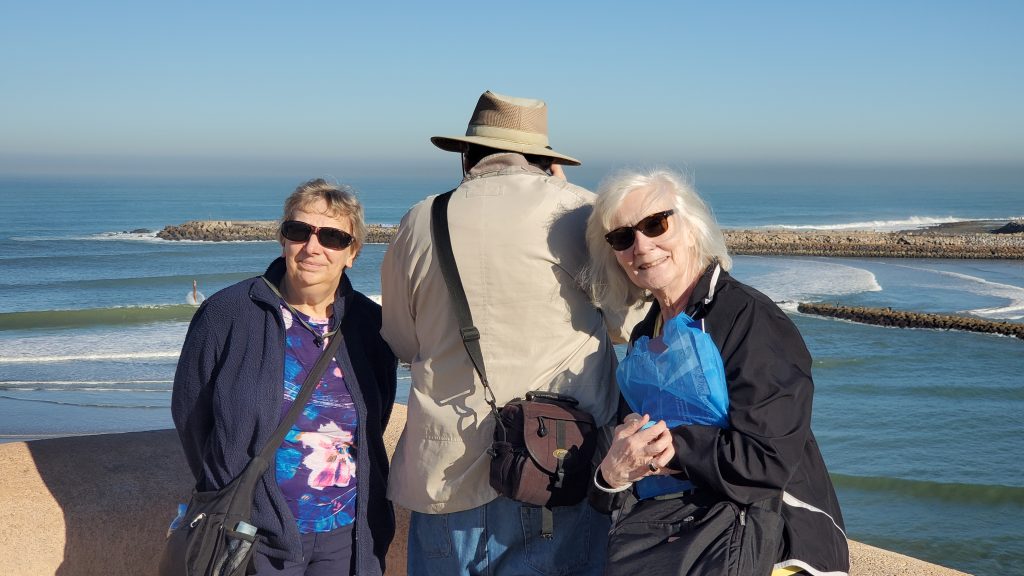
We saw the official, main royal palace – Omar was able to bribe some parking guards to let us have a great parking spot with one of my unearned pomegranates, I’m glad they were coming in handy – and waved to the bored looking royal guards. No idea if the King himself was in residence at the time; let’s just assume he was.
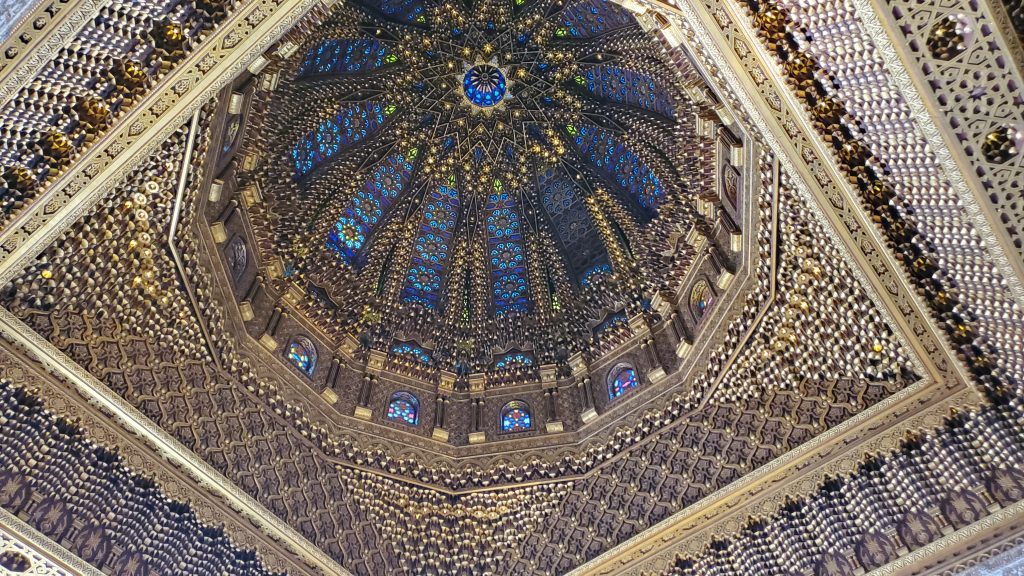
I think my favorite part of the visit to Rabat was the Mohammad V Mausoleum. He’s the grandfather of the current king and the one who was integral in Morocco gaining its independence from Spain and France after World War II. Clearly, the Moroccan people hold him in high regard – his Mausoleum building was some of the most beautiful work I’d seen yet on the trip, densely packed into a small space. While M5’s funerary tomb occupied the center of the chamber of course, I was drawn to the tomb of M5’s son, Hassan II, the father of the current king, which had what looked to be a comfy shag rug/pillow next to it, with a book open in front of it (probably the Qur’an, but we could imagine it was a Dan Brown novel instead). Perhaps a cozy spot for current king M the 6th to hang out next to the grave of his father, in a beautiful space. I gave my dad a big ol’ hug after we left the mausoleum. Sorry I can’t afford to build you a place quite this amazing, pops.
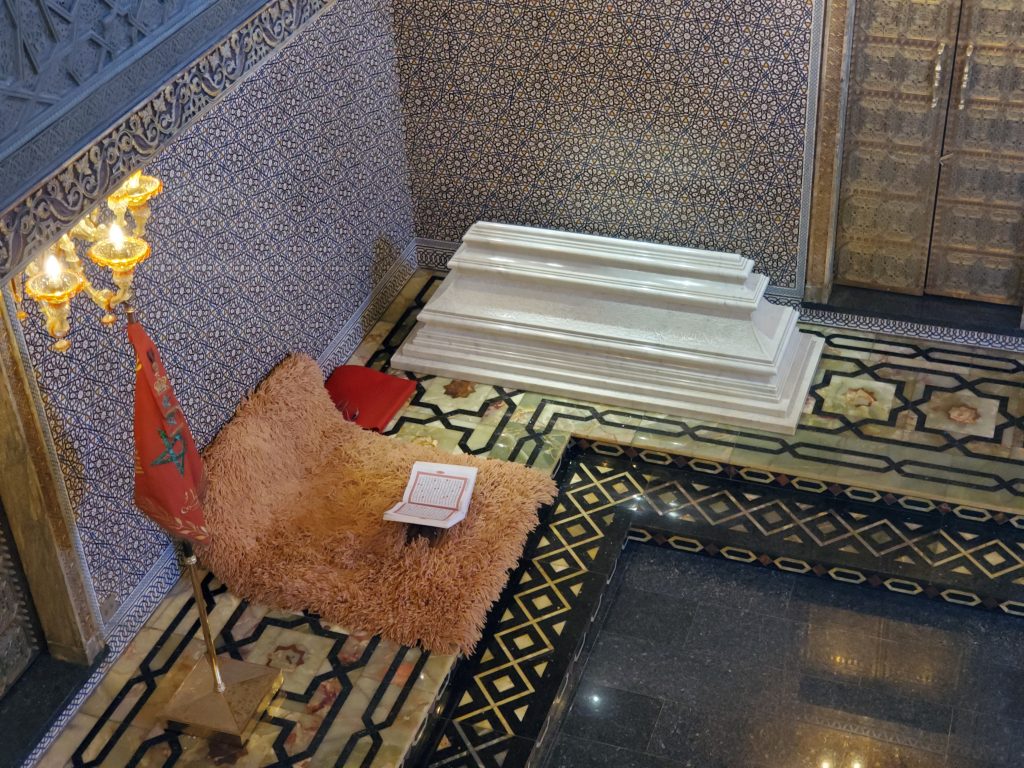
After our tour of Rabat city, it was time to head to our final destination – Casablanca. A short drive as the crow flies, it unsurprisingly had some of the densest traffic of our trip. It’s a huge city, and it seems a lot of Moroccans want to work there! Our lodgings for the next two nights would be the Kenzi Hotel, which while impressively tall, felt more like
After our tour of Rabat city, it was time to head to our final destination – Casablanca. A short drive as the crow flies, it unsurprisingly had some of the densest traffic of our trip. It’s a huge city, and it seems a lot of Moroccans want to work there! Our lodgings for the next two nights would be the Kenzi Hotel, which while impressively tall, felt more like Vanci back in the blue city – a standard conference/business hotel that perhaps was a bit of ‘faded glory’ – the height of luxury when it had opened, but now coasting on its laurels now, 30 years later. Wait, it only opened in 2009 and it already is this dingy and bland? Yeesh. The topmost floor, 28, was dedicated to a restaurant overlooking the city…….but it was closed for remodels during our stay, darn.
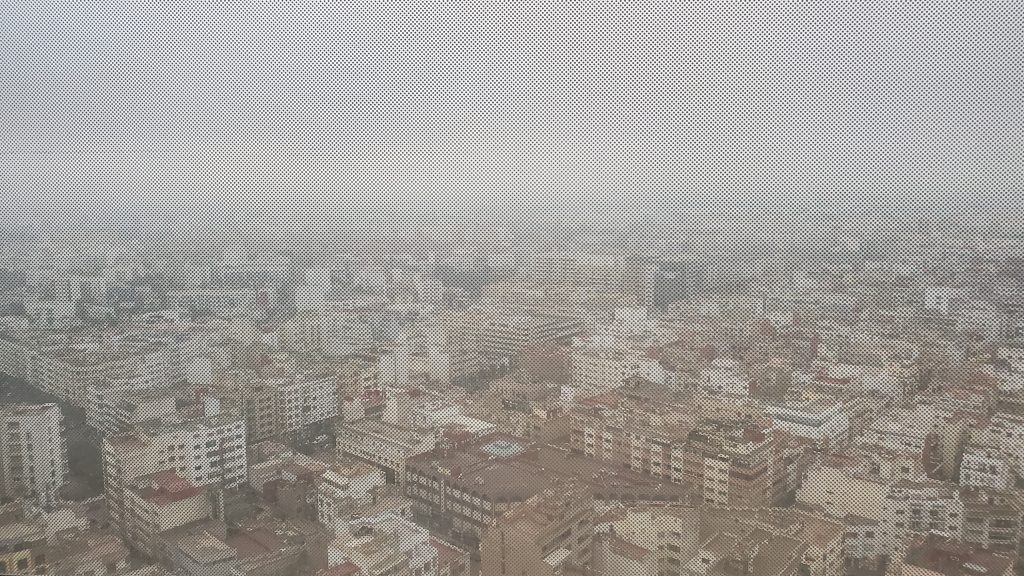
In Casablanca, the definite highlight of the visit was the famed Hassan II mosque, which as you read above, was the father of the current king. This place was huge, definitely the largest mosque I’ve ever been in – the current 14th largest in the world, and #1 on the African continent. It was also the first (and only) mosque that non-Muslim tourists were allowed to go into, and Odynovo had also paid for a local guide here too. She pointed out the beautiful ceiling high above us and asked if we noticed anything unusual about it. Besides being gorgeous, we did not. Turns out that the whole roof can open up like a freaking football stadium! (picture of it in open mode, which we didn’t get to see in person) – this was a relatively recently built, modern mosque that still didn’t have air conditioning, so during huge festivals like Ramadan, when the place might have 20,000+ people inside it, they would open the roof to get some airflow in there. Fantastic. It’s also partially built out over the sea (due to a line from the Qur’an that says the Throne of God is Over Water) and with two exceptions, all the marble and wood and other stone that went into its construction is from Morocco (the exceptions being Italian chandeliers and two white marble columns that frame the mihrab, that enclosure at the head of the mosque (Ras al Masjid; but not a tasty spice) where the imam speaks and everyone is facing toward Mecca.) Apparently the whole place was built in only a few years due to thousands of artisans working nonstop in shifts, 24 hours a day, 7 days a week.
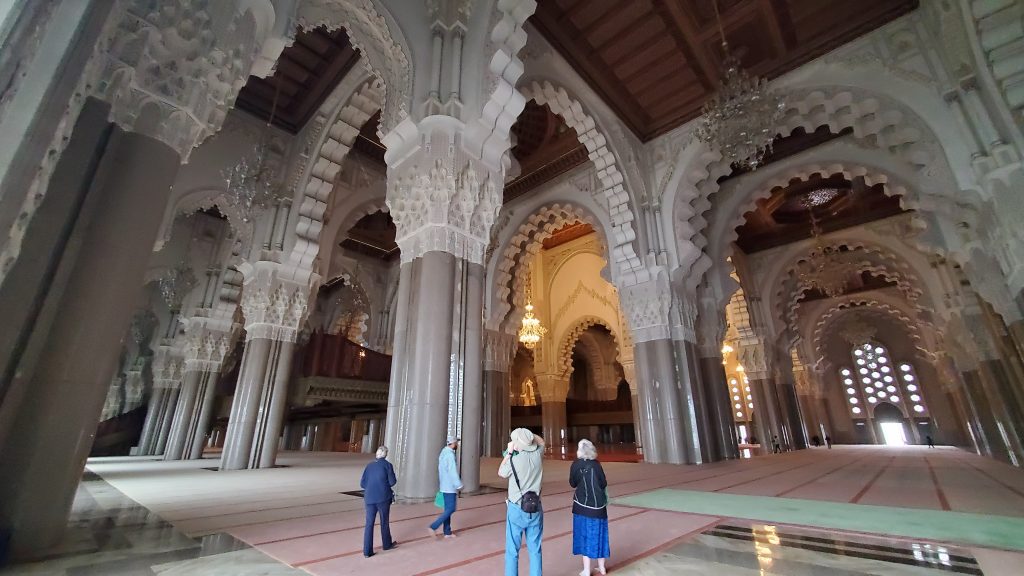
I also liked how our guide took us down into the ritual ablution chamber, part of a mosque I’d never actually seen before, having only performed wuthu once myself before attending Fajr prayer with my neighbor Marwan – but I did it in my own home. There were small windows on the floor of the sanctuary floor that looked down into the ablution chamber. I wonder how they felt about Muslim women being able to see down into these men-only washing chambers during Salaah service times, but due to the size of the mosque, instead of women being behind men on the same floor like most mosques, instead the faithful ladies have an entire second level above the main floor, with wooden screens shielding them from prying eyes. The women have their own ablution chamber (which we weren’t allowed to see). The men’s chamber was pretty gorgeous though, with large stone ‘lotus flowers’ throughout the room that bubbled water upward during big services like Ramadan that allow a dozen men to surround each flower to perform the ritual.
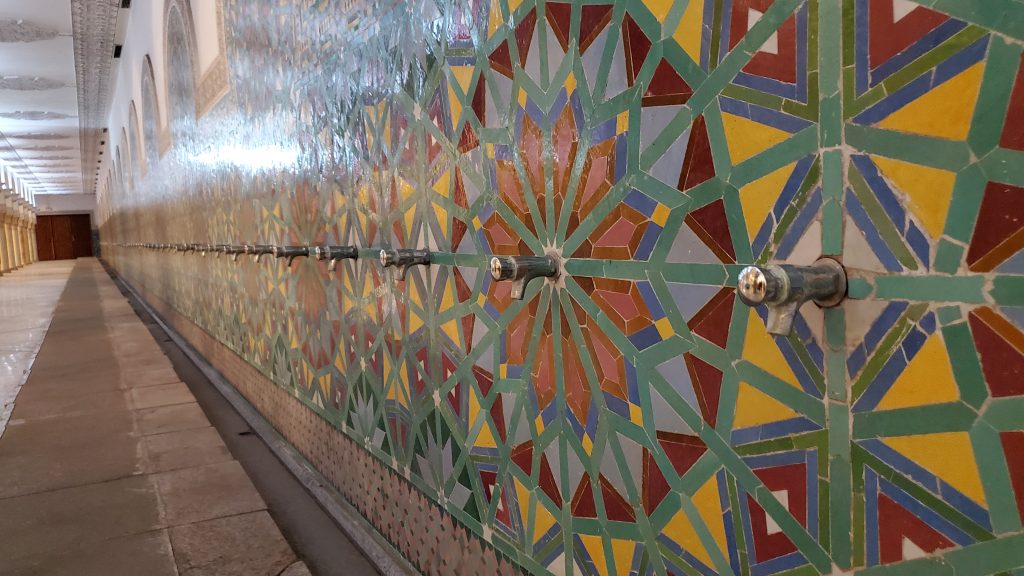
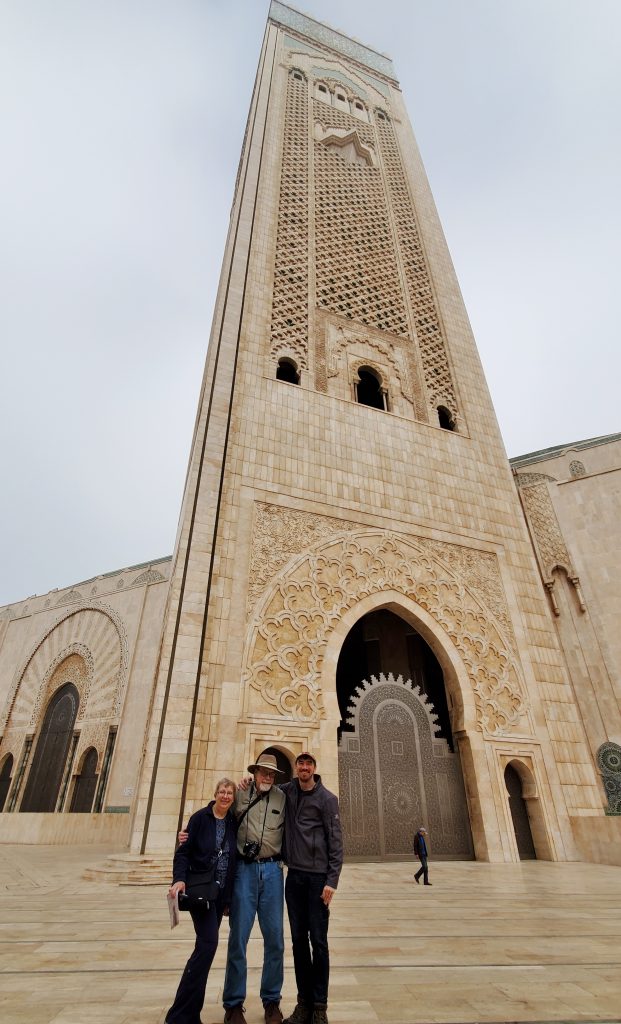
Besides the beautiful mosque, we had a chance to have a fish lunch with Omar. Being a seaside city, of course the fish had been freshly caught that morning. The market that Omar took us too was, I guess you could say “a little pushy” by Midwestern American standards. We were followed around by vendors trying to talk to us, but mostly Omar, how great their fish was in particular, and how everyone else was lying, and please, won’t you stop walking? Buy my fish? It was a little tiring after 5 minutes of this, so in the end we asked Omar to head back in without us, and we’d trust him to select something for us he thought we would like. There was a whole line of… kitchens with tables I guess? Since we were just outside the fish shop, these businesses had sprung up to cook, serve, and present the fish that you the customer had just purchased. I’m not normally a fan of seafood, but everyone had been talking about how great the sea bass was here in Morocco (and how unreasonably expensive it was in the USA by comparison), so I dug in and had to agree it was pretty tasty.
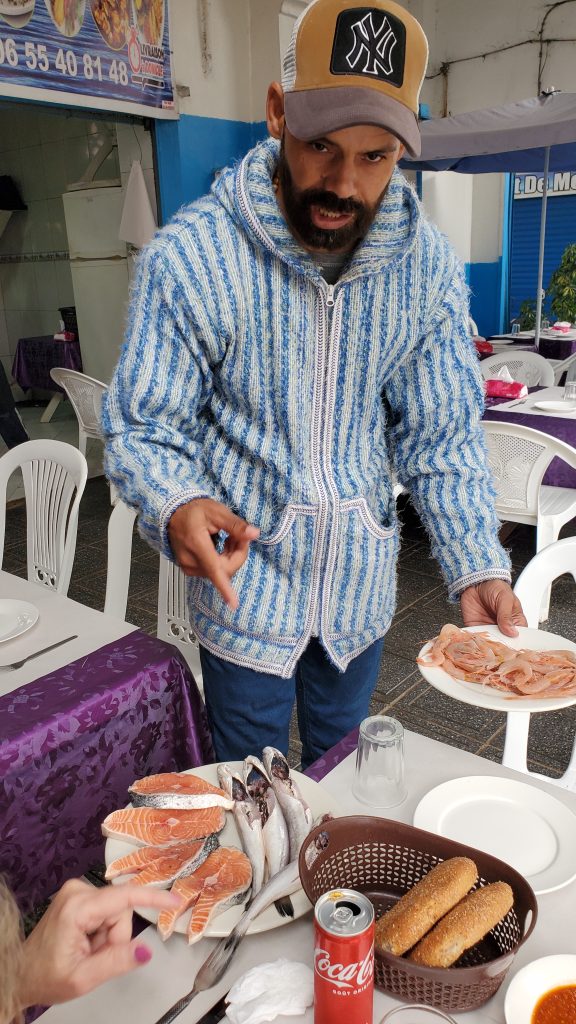
After a brief visit to the beach (so I could say that I had dipped my toes in the Atlantic from Morocco) we wandered back near the oceanfront, past a modern reproduction of the famous Rick’s Cafe from the movie Casablanca (sadly, there is no real Rick’s Cafe or ever was; it was invented for the movie) and ate some tasty street food that Omar purchased for us, such as a honeyed beignet from a crowded stand. It was 60 cents!
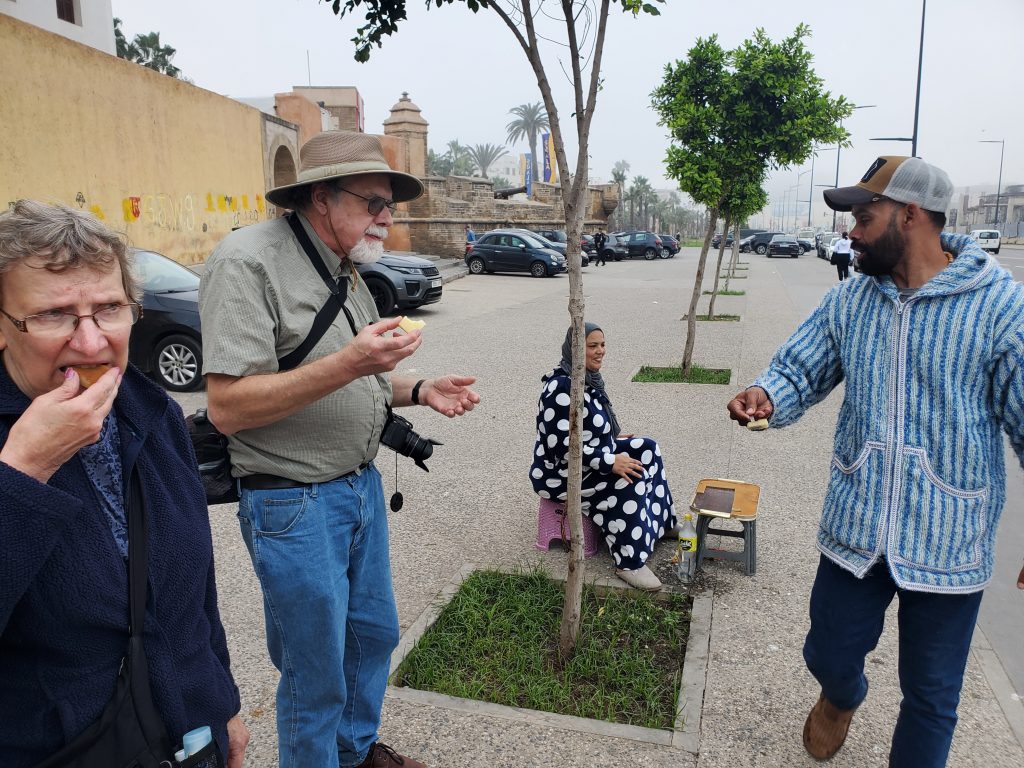
And just like that, it was evening on our final night in Morocco. Still stuffed from our large seafood lunch, we didn’t attempt to get dinner together, but did enjoy extremely expensive cocktails from the piano bar in the Kenzi lobby. As my parents and aunt packed up their stuff late into the evening, I gave into my hunger cravings and used my last paper currency to get a couple sandwiches; one schwarma and one falafel, from a fast food chain around the corner from the hotel. It was tasty, Lebanese style sandwiches (long and thin with pickles in the schwarma, unlike the Jordanian style I was more used to), and I was sad I was only now experiencing Middle Eastern style fast food on the final hours of the trip. Makes me want to go back to Jordan again though.
Overall, it was a great trip. Perhaps a little long by my own standards; usually 14 days is about my mental limit for traveling before I start to experience fatigue/burnout, and this was 16 days. But it was fun to travel with my family, even without my dear Christine, because my elders offered a different viewpoint on things versus my wife and I; she and I basically think the same on so many things, particularly travel-related after 13 years, that it was pleasant to see this region through a different lens of experience.
Should you visit Morocco? Definitely. I was super impressed with the modernity of the country which I’ve touched on in the previous blog posts, and the Berber people, like Arabs of the middle east, are incredibly kind, welcoming, and hospitable. I think I get along better with the loud and uproariously friendly people of the Middle East than the more staid Midwestern people of my homeland anyway, at least for traveling purposes. It helps when you make an attempt, however badly, to speak Arabic with them too – the already high levels of friendliness double or triple when you clearly show you are trying to meet them on their level, even though you clearly cannot! I can definitely see myself going back again. If you can, go and spend some tourism dollars on a friendly, sociable country that is really a bastion of progress in the traditionally conservative Islamic world.
Lastly, I’ll give props to Omar El Jarmouny here too, our intrepid guide – as a freelancer, he’s free to work with whoever he wants, whenever he wants. He told us that now after this trip, he was going to take a break for another 3 weeks to spend time in his town of Agadir with his wife and three kids. If you are thinking of taking a trip to Morocco, reach out to him at arganomar3@gmail.com or Whatsapp, +212 6 08 09 88 97. He would be a great resource to start with!
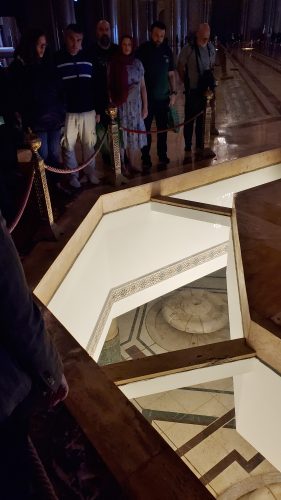


No one has commented on this post - please leave me one, I love getting feedback!
Follow this post's comments, or leave a Trackback from your site